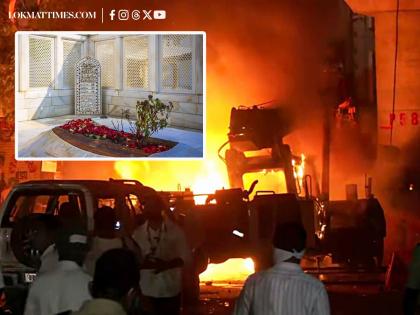Nagpur Violence: Why Is Aurangzeb’s Tomb Protected By ASI? Can the Maharashtra Government Remove It? Explained
By Lokmat English Desk | Updated: March 18, 2025 13:44 IST2025-03-18T13:44:36+5:302025-03-18T13:44:43+5:30
Huge riots and violence erupted in Nagpur on March 18. Earlier in the day, a protest by Vishva Hindu Parishad ...

Nagpur Violence: Why Is Aurangzeb’s Tomb Protected By ASI? Can the Maharashtra Government Remove It? Explained
Huge riots and violence erupted in Nagpur on March 18. Earlier in the day, a protest by Vishva Hindu Parishad (VHP) and Bajrang Dal over the Aurangzeb dome demolition in Maharashtra's Sambhaji Nagar, as per the report of the news agency IANS. 15 police officials sustained serious injuries during the unrest. 25 motorcycles and three cars were set on fire by rioters, as per the reports. Prohibitory orders were issued in the city following a massive clash between two groups.
After Samajwadi Party MP Abu Azmi lauded the Mughal ruler, the Aurangzeb dispute erupted. The situation worsened on March 7 when Udayanraje Bhosale, a Satara MP and descendant of Chhatrapati Shivaji Maharaj, asked that Aurangzeb's Tomb be demolished. Since then, demonstrators have been calling for its removal.
Also Read: Nagpur Violence: 47 Detained, Four FIRs Registered for Rioting, Vandalism and Arson; 15 Cops Injured
Which monuments and locations are centrally protected, and can the Maharashtra government demolish the site? Let's explore.
The protection of monuments and archaeological sites of national significance is governed by the Ancient Monuments and Archaeological Sites and Remains Act (AMASR Act) 1958. Under the auspices of the Union Ministry of Culture, the Archaeological Survey of India (ASI) operates under this Act.
What Does ASI Protect?
- Places where there is proof of early human habitation, such as implements from the stone period and rock shelters. It protects the pre-historic sites.
- Ancient caves carved into rock, such as the Ajanta and Ellora Caves, are known as "rock-cut caves." These caves frequently have elaborate sculptures and inscriptions.
- Buddhist constructions, like the Sanchi Stupa, are called stupas.
- Ancient temples have a variety of architectural designs, such as the Brihadeeswarar Temple and the Sun Temple in Konark.
- Important Islamic buildings, such as the Qutub Minar, Aurangzeb, and Humayun's Tombs.
- It takes charge of archaeological sites, such as the ruins of Nalanda University, where important discoveries have been made.
According to reports, the actual date when the ASI classified Aurangzeb's tomb as a protected monument is unknown. Nonetheless, it was acknowledged as a historically and culturally significant location, and ASI looks after this place under the Ancient Monuments and Archaeological Sites and Remains Act of 1958.
Aurangzeb dies in 1707 in the Ahmednagar district of Maharashtra. According to his will, he was buried in Khuldabad near the dargah of his spiritual guru Sheikh Zainuddin. His tomb has a huge historical and cultural value.
Why ASI Protects Aurangzebs Tomb?
- The reign of Aurangzeb, the sixth Mughal emperor, is regarded as an important chapter in Indian history. The Mughal era and its effects on the Indian subcontinent are commemorated by his tomb.
- The tomb is a straightforward but important illustration of Mughal design. Aurangzeb's modest tomb, which reflects his personal austerity, contrasts with the opulent graves of previous Mughal rulers.
- Along with the tombs of other well-known people and saints, the tomb is a component of Khuldabad's greater complex of historical landmarks. It is therefore a significant religious and cultural site.
Since the ASI considers Aurangzeb's tomb to be a "Monument of National Importance," the state government is unable to de-notify it. Under the Ancient Monuments and Archaeological Sites and Remains Act, 1958 (AMASR Act), the Central Government has the authority to delist any such monument.
During the opening of the first Shivaji Maharaj temple, Maharashtra CM Devendra Fadnavis said, "It was "unfortunate" that Maharashtra had to preserve and look after the tomb of Aurangzeb, a man who murdered thousands of people. We must follow the law because it is protected by the ASI, but I can guarantee you that only Shivaji Maharaj will be exalted. I will not permit Aurangzeb to be glorified or elevated."
Open in app